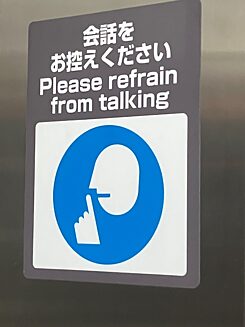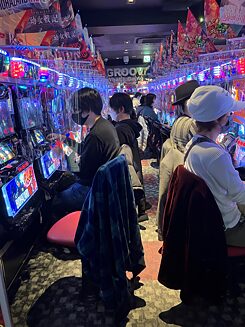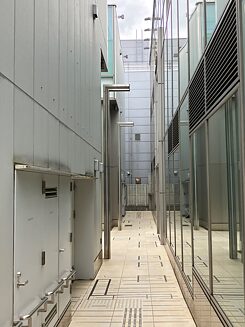Word! The Language Column
Ma, Mu and the Silence of Noise

Jan Snela’s memories of his trip to Japan take him back to the ambient noise in Tokyo…. and the shrill cries of Japanese cicadas, as captured in a Bashō haiku. Tokyo is overwhelming, but he comes across a Japanese word that encapsulates the paradoxical emptiness and absence he feels in the teeming city.
By Jan Snela
 In many places Japan is quite concerned about silence ... – sign in an elevator
| Photo: Jan Snela
Ask anyone in Japan what their favourite haiku is and they’ll recite: “Silence all round / the cicadas’ shrill cry / bores deep into the rock.”. At least that was the upshot of a private poll I conducted there. The respondents were: 1. Kimie, my bed-and-breakfast hostess in Kamakura. 2. Tsunematsu-San, the nice explainer dude at the Fukagawa Edo Museum in Tokyo, who taught me about the tools and customs of 17th-century Japan. And 3. Kumiko, sound artist Junya Oikawa’s manager, both of whom I met in Kōchi. So is this shared fondness for Bashō’s haiku a coincidence? Or some national thing – that every kid has to learn the poem by heart at school? And yet their enthusiasm didn’t strike me as having been drummed into them, it seemed genuine and heartfelt.
In many places Japan is quite concerned about silence ... – sign in an elevator
| Photo: Jan Snela
Ask anyone in Japan what their favourite haiku is and they’ll recite: “Silence all round / the cicadas’ shrill cry / bores deep into the rock.”. At least that was the upshot of a private poll I conducted there. The respondents were: 1. Kimie, my bed-and-breakfast hostess in Kamakura. 2. Tsunematsu-San, the nice explainer dude at the Fukagawa Edo Museum in Tokyo, who taught me about the tools and customs of 17th-century Japan. And 3. Kumiko, sound artist Junya Oikawa’s manager, both of whom I met in Kōchi. So is this shared fondness for Bashō’s haiku a coincidence? Or some national thing – that every kid has to learn the poem by heart at school? And yet their enthusiasm didn’t strike me as having been drummed into them, it seemed genuine and heartfelt.
Bear in mind that Japanese cicadas bear no relation to ours, which sound idyllic, like the air catching fire. Theirs sound more like a UFO landing. Like radioactivity, if we could hear it. Or like contemporary art music. At any case, you’ll find no more trace of quiet tranquillity in their strident stridulation than in the blaring of the giant video screens at the Shibuya crossing or in the frenzied cacophony of the hellish pachinko parlours. So Japanese cicadas fit right in with the local soundscapes, which are full of all sorts of different stridencies. And yet, whenever my thoughts turn to Japan, I feel a glistening tranquillity inside.
Memories of Tokyo
 Japanese people calmly in the hellish noise of a pachinko-parlour
| Photo: Jan Snela
Memories of my first trip to Tokyo roughly twenty years ago: Wandering blissfully through a city that extends beyond its every horizon. Before that, a Zen sesshin in Kamakura: counting breaths – 1, 2, 3, 4, 5, ...10 – over and over again from half past four in the morning till nine o’clock at night. Me at Tokyo Bay. Me at the top of Tokyo Tower. Me with two teenage girls, Mai and Yu, who caught me in a moment of weakness in Ueno Park and took me, a gaijin, i.e. a foreigner, by the hand, one on either side, and led me giggling down the street to the Sensō-ji, the Kannon shrine in Asakusa. Then to the cinema. And then into a booth in which we took photos of ourselves and decorated them on a screen to loud music. Not a single picture of the two of them without a victory sign or bodybuilder pose. Then, over sushi, giggling at the gluttonous weirdo sitting behind me. Delicious rice balls from Mai and Yu’s mothers. No need to thumb through the guidebook. A clear-cut case of a win-win situation.
Japanese people calmly in the hellish noise of a pachinko-parlour
| Photo: Jan Snela
Memories of my first trip to Tokyo roughly twenty years ago: Wandering blissfully through a city that extends beyond its every horizon. Before that, a Zen sesshin in Kamakura: counting breaths – 1, 2, 3, 4, 5, ...10 – over and over again from half past four in the morning till nine o’clock at night. Me at Tokyo Bay. Me at the top of Tokyo Tower. Me with two teenage girls, Mai and Yu, who caught me in a moment of weakness in Ueno Park and took me, a gaijin, i.e. a foreigner, by the hand, one on either side, and led me giggling down the street to the Sensō-ji, the Kannon shrine in Asakusa. Then to the cinema. And then into a booth in which we took photos of ourselves and decorated them on a screen to loud music. Not a single picture of the two of them without a victory sign or bodybuilder pose. Then, over sushi, giggling at the gluttonous weirdo sitting behind me. Delicious rice balls from Mai and Yu’s mothers. No need to thumb through the guidebook. A clear-cut case of a win-win situation.The clattering of pachinko balls. A bonsai reflected in the glass façade of a skyscraper, with a sparrow chirping shrilly inside the building. Like the screeching of the cicadas boring deep into the rock. When I think back on those days in Japan, I listen into the interstices of time. Where the seconds, hours and weeks fuse and separate. There’s a Japanese word for this: ma (間), which means something like distance, duration, the emptiness in-between, an interval. The syllable that practitioners of meditation have been chanting in Zen monasteries for centuries (when they’re not counting their breaths) sounds almost exactly the same: mu (無), which means something like “no” or “not”. Both refer to a moment of absence, rather than any postulated fullness of being, that is present in all Asian cultures.
A sense of silence
 Sudden silence (Tokyo) – as loud as it was just a moment ago, quite often you suddenly find yourself in complete silence
| Photo: Jan Snela
The Heart Sūtra, a key canonical text in every school of Buddhism, can be reduced to its core statement: form = emptiness, emptiness = form. The Zen-inspired composer John Cage once experienced in an anechoic chamber that sounds themselves make up silence. Having braced himself for the absence of any noise, he was startled to hear the buzzing of his own nervous system and the hum of the blood in his veins. Bashō may have experienced a similar shock with those cicadas during one of his rambles into the here and now. In his cicada haiku, at any rate, there is no silence without the noise that forms its contours.
Sudden silence (Tokyo) – as loud as it was just a moment ago, quite often you suddenly find yourself in complete silence
| Photo: Jan Snela
The Heart Sūtra, a key canonical text in every school of Buddhism, can be reduced to its core statement: form = emptiness, emptiness = form. The Zen-inspired composer John Cage once experienced in an anechoic chamber that sounds themselves make up silence. Having braced himself for the absence of any noise, he was startled to hear the buzzing of his own nervous system and the hum of the blood in his veins. Bashō may have experienced a similar shock with those cicadas during one of his rambles into the here and now. In his cicada haiku, at any rate, there is no silence without the noise that forms its contours.In Japan – as evidenced by another private poll I conducted – hardly anyone knows much about Zen anymore. Tell them you’re into Zen and they’ll be as disconcerted as we’d be if someone told us that they pray a rosary every day. But my impression is that the Japanese, much as they seem content with all that ambient noise, hold a deep sense of silence inside them. Silence not as something that follows after the shrill cries have died down, but as something listening from deep inside those cries.
Word! The Language Column
Our column “Word!” appears every two weeks. It is dedicated to language – as a cultural and social phenomenon. How does language develop, what attitude do authors have towards “their” language, how does language shape a society? – Changing columnists – people with a professional or other connection to language – follow their personal topics for six consecutive issues.